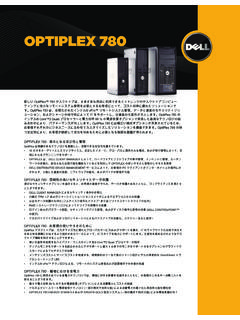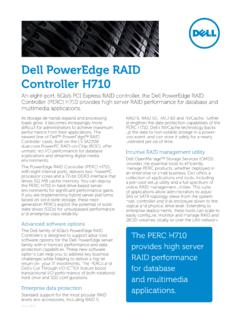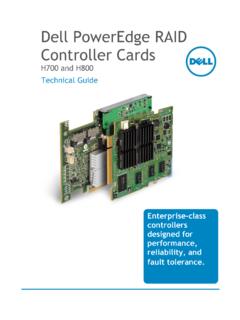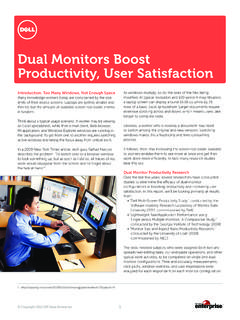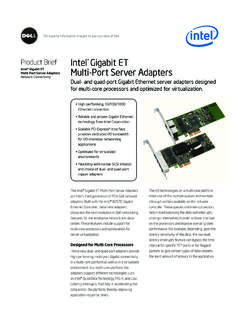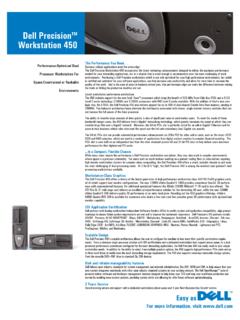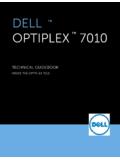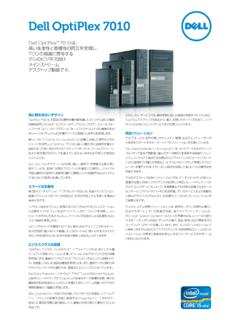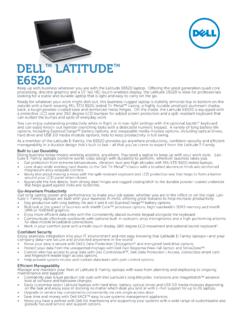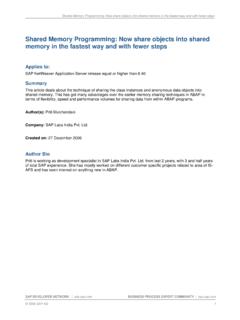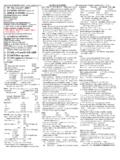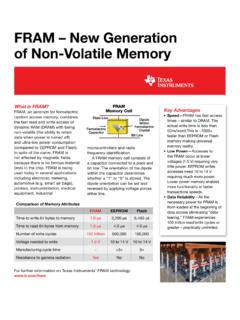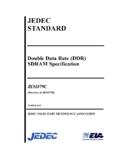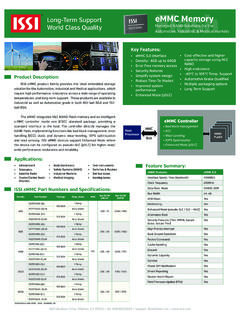Transcription of Installing and Upgrading DDR3 Memory - Dell …
1 Installing and Upgrading ddr3 Memory : Quick Reference Guide for New dell PowerEdge Servers August 19, 2009 Thomas Cloyd dell , Inc. | Server Product Group Introduction This paper provides Memory guidance at time of system purchase for later Memory upgrades for dell 11th Generation 610 and 710 Series PowerEdge Servers. The purpose is to understand what dell will support, simplify terminology, and describe rules when Installing Memory with examples of upgrade paths. Quick Reference Guide Table 1 is intended for quick reference in order to understand what dell will support and the rules governing Memory configurations.
2 Table 1: Quick Reference Memory Guide DIMM Feature Combine Rules Mixed Type (RDIMM / UDIMM) No Not Supported Mixed Ranks Yes Single (SR) and Dual Rank (DR) DIMMs can be mixed. If mixing SR or DR with Quad Rank (QR) DIMMs, the first slot of each channel populated (first two white tab DIMM slots on each processor: A1, A2, B1 & B2) must be populated with the QR DIMM. Only two QR DIMMs are permitted per channel because the maximum of total ranks per channel is 8. Mixed Capacity Yes All populated channels must have the same DIMM arrangement. Example with Channel 1: if bank A is populated with a 4GB DIMM (slot A1), bank B with 2GB (slot A4) and Bank C is empty (slot A7), all Memory Channels must be populated that way.
3 (see figure 5) Mixed Speeds Yes If Memory modules (DIMMS) with different speeds are installed, all DIMMs will operate at the speed of the slowest installed DIMM. Also, if any DIMMS (regardless of speed) are installed in the third bank (bank C: slots A/B 7, 8 or 9), the maximum system Memory speed will be 800 MHz. This is the current maximum frequency supported by Intel and dell , when DIMMS are installed in slots 7, 8 & 9. Mixed Vendors Yes Any dell sourced ddr3 DIMMs are supported, regardless of vendor or vendor mix. Where possible, dell recommends using the same DIMM manufacturer. Identifying the correct DIMM slots in 610 and 710 Series servers (M/R/T610 and M/R/T710 servers) Pre-existing DIMM positions may not be correct for Upgrading .
4 When Upgrading Memory modules, you must follow these population guidelines. Incorrect population will result in BIOS warnings or errors. PowerEdge M710/R 710/T710 Figure 1: This is the physical Memory layout on the R710/M710/T710 (technical schematic). White tabs indicate first slot of each channel. ** PowerEdge M610/R610/T610 Figure 2: This is the physical Memory layout on the M610/R610/T10 (technical schematic). White tabs indicate first slot of each channel. ** Overview Intel Architecture dell 11Th Generations servers (610 & 710 Series) released March 2009 use the new Intel Xeon 5500 series CPUs that support the new ddr3 Memory technology.
5 Each CPU has three separate Memory controller hubs (MCHs). Figure 1 illustrates this new CPU architecture and Memory layout for 18 DIMM systems the 710 Series servers. Due to this new technology, there are limitations on Memory speed. Total system Memory speed is dependent on the CPU, DIMMs populated per channel, and the DIMM ranking. For example, one restriction is that Quad Rank (QR) DIMMs must be the first DIMM installed in a channel ( Memory bank #1).* A1A4A7A2A5A8A3A6A9B9B6B3B8B5B2B7B4B1 Memory ChannelsMemory ChannelsCh 1Ch 1Ch 2Ch 3Ch 3Ch 2 CPU ACPU BA1A4A2A5A3A6B6B3B5B2B4B1Ch 1 Memory ChannelsMemory ChannelsCh 1Ch 2Ch 3Ch 3Ch 2 CPU BCPU A*Note that only two Quad Rank DIMMs may be installed per channel.
6 This is due to the limitation of only having 8 total ranks per channel. Single Rank (SR): one row of DRAM comprising 64-bits of data. Dual Rank (DR): two rows of DRAM comprising 64-bits of data each. Quad Rank (QR): four rows of DRAM comprising 64-bits of data each. Figure 3: 710 Series Servers Memory illustration (not a technical schematic of motherboard) ** Figure 4: 610 Series Servers Memory illustration (not a technical schematic of motherboard) ** Balanced Memory Configuration Any DIMM configuration that does not adhere to the guidance below is unbalanced and generally not recommended. Unbalanced configurations can potentially generate BIOS warnings or error messages.
7 The only exceptions to this statement are a few low DIMM count offerings and specific configurations for RAS features (such as Advanced ECC and Mirroring) which only populate 2 channels and do not use the third channel. A Balanced Memory Configuration is a Memory configuration where both CPU 1 and CPU2 (if installed) both have identical Memory populations on all Memory channels. This does not mean all the DIMMs must be the same size/capacity. Balanced means that the same size/capacity DIMM must be installed in the same Memory bank on every populated Memory channel. Bank A must have all the same DIMMS installed in every populated slot.
8 Bank B must have all the same DIMMS installed in every populated slot. Bank C must be done in the same way fashion. Figure 5 provides an example of a balanced configuration on the R710/M710/T710. Figure 6 provides an example of a balanced configuration on the R610/M610/T610. Figure 5: This is an example of a balanced Memory configuration for the R710/M710/T710 with 36 GBs of Memory (6 x 4GB and 6 x 2GB) . (Not a technical schematic of motherboard) ** Figure 6: This is an example of a balanced Memory configuration for the R610/M610/T610 with 24 GBs (6 x 4GB) of Memory . (Not a technical schematic of motherboard) END ** END
